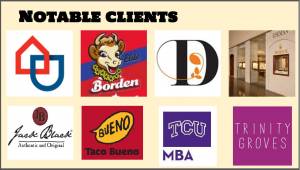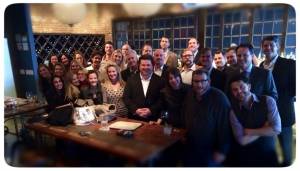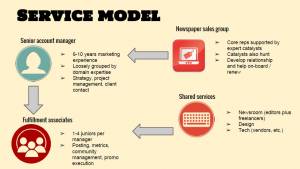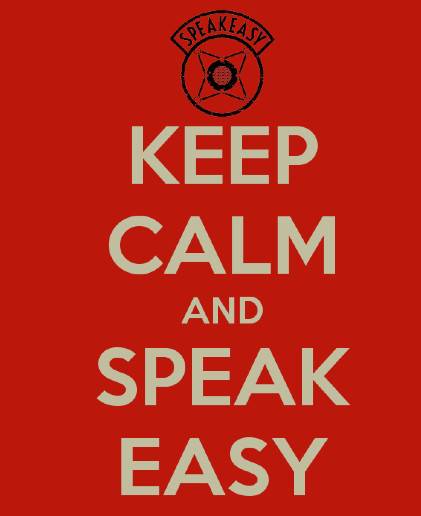SpeakEasy's high end agency tops $3 million after two years
Early success, new challenges for partnership between Dallas Morning News and Slingshot, a local agency
Media: Dallas Morning News
Initiative: SpeakEasy, a 50/50 partnership between Dallas Morning News and Slingshot, a local digital marketing agency
Key executive: Mike Orren, President; Lyndsay Jacaman, Chief Revenue Officer, SpeakEasy and GM of Digital Products, Dallas Morning News
Summary: In September 2012, the Dallas Morning News launched a new agency, SpeakEasy, in partnership with a local ad agency Slingshot and tapped Mike Orren, a local editor and entrepreneur, to head up the new venture. After three years the team has 70 clients, and a staff of about 20, including two editors who use freelancers to post 1,000 pieces per month. The business cashflowed in December, 2013 and has $3 million projected on its' 2014 revenues. This report roadmaps their strategy. At the end is a summary of key components.

1. What products to sell
The first decision for every agency is what products and services to provide. SpeakEasy focuses exclusively on three areas large enough for flexibility but focused enough to develop expertise: Content marketing, social posting and promotions.
"We are more like a custom publishing house that acts like an agency," says Mike Orren, president of SpeakEasy.
His goal for clients is to "create an overarching strategy for your brand that speaks to your customers."
Many of the campaigns are customized; however core products typically include content such as custom blogs on the client site and social posts.
Here's how these programs - content (including native), social and promotions - work together:
• Content resides primarily on client-owned site websites.
• About 2/3 of social posts link to the client-site, typically to content and offers. Orren is well-known for the message, "If it does not drive traffic back to a site you control, you are share-cropping on Mark Zuckerburg's farm." This theory provides the reasoning for continuous rich content creation on the client sites as part of the social posting schedule.
• Promotions are used both to build an initial audience base and to convert them via offers. "We have to do something first to bring (the audience) in. So we do promotions early and then again with more of an engagement message such as a special or coupon for checking in," Orren said.
"If a company has 110 facebook likes, you can put out a promotion, but there is not anybody to take you up on it, unless you spend a ton of money on media. We are building their own audience."
Early on sweepstakes are typically straight up, enter to win a $550 gift certificate is a common one. Orren aims to keep giveaways related to the company so that they draw a relevant audience. Wier Furniture store, for example, promoted an "enter to win $500" towards a buy at the store for Mom's who checked-in around Mothers Day, increasing engagement by 5 times, and adding 400 new fans.
Another offer - for a free lamp to every visitor who checked-in, using lamps from excess inventory - drew a line out the door during a sale weekend.
A bariatric surgeon gave away a FitBit for a bariatric surgeon and a sleep disorder center offered up a free sleep tracker.
Later in the campaign, promotions are more likely to be sent via social media channels, though customers still buy media.
"We drive in customers organically, but campaigns always works better if we amplify with paid media... but it should be cheaper than the media they would have spent. "
• Native ads that reside on the Dallas Morning News' high traffic events site are used to bump up traffic to the client site. Native ads are marked "sponsored" and promoted on the right rail of the channel's home page.
"Native ads are like content on steroids," Orren says.
"They gets extra reach and drive people back to the website. But readers just bounce off the client site if there is nothing there, so having owned-content on the client site is critical.
"Look at what the ads drive to... is it something the reader is going to engage more deeply? Publishers have a huge opportunity to help create that environment."
Minimum buys start at $3,000 a month for six months. The team puts a size minimum on accounts because they have found the churn rate is higher for smaller customers.
"We always make the same mistake. The little clients are more trouble than the big ones," Orren said. DMN has a separate initiative aimed at smaller clients, so Speakeasy is free to target independently of the company's overall market share goals.
With this kind of of budget, content programs include about 17 new posts a month for blogs and two to three articles a month for Native ads.
Outside the standard content, a content swat team does digital problem solving that has included reputation repair, essentially drowning the negative press in better content.
• How to handle sales
Sales and sales management are the core contributions of the Dallas Morning News side of the partnership. The GM of Digital Products for the Dallas Morning News, Lyndsay Jacaman, serves also as The Chief Revenue Officer of SpeakEasy, with three hunters who "incite" and assist DMN sales reps as well as handle their own accounts.
The 80 DMN sales team, however, is the primary driver of business development.
"They already have the relationships," Orren says.
Core product sales reps receive a commission on one plus years on sales of SpeakEasy content marketing, social and promotions products. On the 13th month they get a big spiff, before losing commissions.
Commissioning core reps is important, Orren says, "so they don't feel compelled not to use us."
Originally renewals were handled by non-selling account managers, but today sellers handle renewals as well as new sales.
Content marketing sales have a long close cycle - about 60 days - and are considered incremental revenues for reps, hence the continued reliance on a separate team to incite and activate accounts.
• Which accounts to call on
There is no single identifier for the best prospects for content marketing programs, Orren says.
The SpeakEasy team started with Jacaman looking at the largest newspaper categories, scouting for companies whose social promotions are "lame" and where competitors were doing a better job. Jacaman initially reviewed the top 20 or so accounts from categories in the 100 newspaper accounts to find good candidates.
She used a tool, polygraphmedia.com, to vet accounts for deep competitive information and establish the sales call plan; sellers approach accounts with some rich information on social and content-oriented competitive issues.
"They might say, 'Hey, we've done an analysis of your blog and social presence... the average competitor is getting "x" and you are getting "y" and we think the reason is 'z'.... and we can help,'" Orren said of the approach.
Another current tactic for identify hot prospects is to look through recruitment ads for full time digital marketers, and then approach the company with another option: 'Don't hire a person, hire a team.'
In this case, "We are competing against the job pool as opposed to another company," Orren explains."
• Top categories sold
In the end, top categories sold by volume included hospitality, auto, retail and healthcare.

However in total revenues, the top categories are home services, retail, auto and technology start-ups. By revenue is an important factor since the higher the spend, the lower the churn, and higher the margin. These are great categories for agencies to target.

One of the largest clients is American Home Shield, a home warrantee company. Their strategy includes creation a new content site called homestructions.com to house content created for the social posting schedule. Here's a look at their site and Facebook page created by SpeakEasy:

Another client is the Dallas Entrepreneur Center, for whom custom content is delivered via newsletter that links back the site:

Unique brands are a special category of customers. Brands can build preference to support distributors and stores. "This is why you should consider creating original content, and for a whole brand."

DFM itself is also a client. SpeakEasy now runs the social channels for the business sections, magazines and events. They have also provided help with strategy for the flagship media's social media, driving back into revenues.
"It helps we are outside the building, adds 20 points to your IQ when you walk in the door,"
• The fulfillment plan
The core contribution of Slingshot is the agency management, which is different than managing a print production house. The majority of agency staff are engaged in editorial and fulfillment and everyone - from the president on down - tracks their time to the minute every day.
Besides Orren, the full list of SpeakEasy staff includes:
- 7 Dedicated account Managers with six to ten years of experience in journalism or marketing
- 12 Fulfillment Associates
- Ops Director
- Two Editors
- Office manager

A deep onboarding process for clients takes about a month and starts with interviewing the client and its customers to establish editorial "voice" and a customer personae (age, interests and other demographics).
Orren's team often "goes to the point that customers touch" to get a better feel, or, if it is a B2B situation, talks to customers directly to understand their point of view.
The dedicated account managers handle the day-to-day, face-to-face contacts and are the 'go betweens' communicating with editors about the voice, personae and where the customer is in the funnel.
A pod of two to five people is also assigned to work on the account. Here's a diagram of the model.

The account team populates a freelance management system, Kapost (a platform "Like e-byline but heavier on platform') with orders for editors that include deep information on person and voice.
Editors then use the system to query their team of freelancers - some general and some specialists - who take the work on a first come first serve basis, and repost to the system. The two editors field 45 stories per day.
"We use freelancers we have sourced ourselves. They know the rules to follow, and can see the voice, personae of the buyers."
One of the rules is that the client has no input in the actual story.
Social posting is executive by the associates, rather than freelancers, since voice and choice need to be both more fluid and consistent on a day-to-day basis over time, using a hybrid model of scheduled and unscheduled content. At the beginning of each month 30 days of posts are created and scheduled. This calendar is infilled with additional posts based on "what comes up" during the month. Typically the total volume of social posts is about 100 per month, but "it's not an exact number."
A typical client for content marketing will receive about 17 articles a month. There are currently three customers also running native ads on the DMN site, with about two to three articles a month.
The agency also has the rights to use DMN archived content, but typically doesn't.
"We thought it would be the source, what we found is that even though clients are excited about it, they want custom content. Photos are great and much easier to use, but custom content is needed because it can be edited."
• Running a newsroom like an agency
The agency management services handled by Slingshot are designed to ensure accounts are profitable, even given highly customized services. Here are some elements that make agency management more efficient:
- Robust freelance management. As mentioned, a key to organizing the team of freelancers with just two editors is Kapost - a more complex version of e-byline which can manage hundreds of freelancers and about 1,000 articles a month, written for 70 unique audiences in brand specific voices. It's expensive - about $1,000 a month.
"Everytime I get the bill and sign it, I think there's got to be a different way (than Kapost)," Orren says of the platform.
"But we always come to the same conclusion: We could not do this without this kind of system. E-byline is like Kapost light, and Newscred has a version (of high volume freelancer management)...but nothing manages deadlines and freelancers across hundreds of articles and dozens of clients as easily."
- P&Ls on each customer. Unlike newspaper advertising, the agency treats each customer as a business; a P&L per customer is created by the CFO and reviewed by the team monthly - weekly if the account is not making a profit.
To create the P&L, every hour of every employee is tracked and either charged to the account, or to an inhouse account, such as "authorized time off".
"Sometimes even I might get lazy and forget, then you have to go back and post every hour. it's a discipline,'" Orren said.
The minimum fees of $3,000 do not include any paid distribution, only "a number of hours of service from the staff." Still Orren says, much of the work is front loaded and accounts are often not profitable for several months.
Lessons learned
One of the biggest lessons learned is finding out what niche you want to service - defined by both quantitative size and qualitative characteristics. The latter includes both the potential for a true national brand voice and the willingness of the client to cooperate but not get overly involved.
"You want to know how the client is to deal with. Are they cooperative and transparent or is this the kind of account that won't give the Google analytics log-in, or lose it, or want to do part trade?"
With margins on accounts at risk, customers that get overly involved, on the other hand. wind up costing money and a few accounts have not been profitable as a result."
"If a customer is asking where the results are in the first 30 days, that's a sign," Orren says.
"We found increasingly that the question was, is the client cool? So we are starting to do two levels, the more involved the client wants to be, the more we are going to charge them."

Mike Orren, President, Speakeasy

Lindsay Jacaman, Chief Revenue Officer, Speakeasy

The author, Alisa Cromer is publisher of a variety of online media, including LocalMediaInsider and MediaExecsTech, developed while on a fellowship with the Reynolds Journalism Institute and which has evolved into a leading marketing company for media technology start-ups. In 2017 she founded Worldstir.com, an online magazine, to showcases perspectives from around the world on new topic each month, translated from and to the top five languages in the world.






